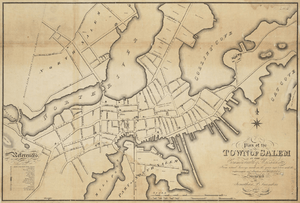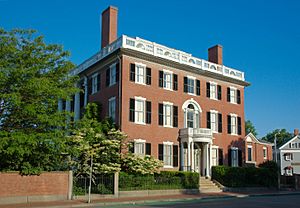Salem Common Historic District (Salem, Massachusetts) facts for kids
|
Salem Common Historic District
|
|

Wintertime view of historic homes
|
|
| Location | Salem, Massachusetts, U.S. |
|---|---|
| Built | c. 1667 |
| Architectural style | Colonial Revival, Late Victorian, Federal |
| NRHP reference No. | 76000303 (original) 02000694 (increase) |
Quick facts for kids Significant dates |
|
| Added to NRHP | May 12, 1976 |
| Boundary increase | June 27, 2002 |
The Salem Common Historic District is a special historical area in Salem, Massachusetts, United States. It includes the famous Salem Common and many old buildings around it. This district is roughly bordered by Bridge, Derby, and St. Peter's streets, and also by Collins Cove.
The Common itself was created way back in 1667. Back then, part of it was a swamp. For many years, until 1802, there was no fence around it, so farm animals could walk freely across the area. In 1802, people started a collection to make the park more beautiful. The strong iron fence you see around the Common today was built in 1850 and has been fixed up over the years.
Near the north entrance of the Common, there's a white archway. The first archway was designed by a famous architect named Samuel McIntire. It had to be taken down because it was in bad shape. The archway that stands there now is a copy of the original, built in 1976.
This historic district was added to the National Register of Historic Places on May 12, 1976. This means it's recognized as an important historical site. The district was made even bigger on June 27, 2002. It now includes the Essex Institute Historic District, which is a group of buildings owned by the Peabody Essex Museum.
Contents
Historic Homes in the District
The Joseph Story House
The Joseph Story House was built in 1811. It was made for Joseph Story, who was a very important judge on the U.S. Supreme Court. This house is located at 26 Winter Street. It was added to the National Register of Historic Places in 1973, recognizing its historical value.
The Andrew-Safford House
The Andrew–Safford House was built in 1819. It was designed in the Federal style, which was a popular building style at the time. The house was built for a rich merchant who traded furs from Russia. You can find it at 13 Washington Square. Today, the Peabody Essex Museum owns this impressive building.
When it was being built, people said it was the most expensive house ever built in the United States at that time! Its tall front and four large columns that go from the ground all the way up to the third floor make it one of the most amazing houses in Salem.
Besides being part of the Salem Common Historic District, this house is also part of the Essex Institute Historic District.
The John Bertram House
The John Bertram House was first built in 1819 for a man named John Forrester. He was married to one of Joseph Story's sisters. Later, Captain John Bertram bought this grand Federal-style house from John Forrester. Captain Bertram then sold it to Colonel George Peabody.
Colonel George Peabody lived in the house for about 60 years. While he lived there, he made the house bigger by adding a dining room on the first floor.
Around 1930, the house was bought by the estate of Captain John Bertram. It is now called the John Bertram House and serves as a home for older people.
Salem: Birthplace of the National Guard

Salem has a very special place in American history because it's considered the birthplace of the Army National Guard. In 1637, the first "muster" happened on Salem Common. A muster is when soldiers gather for training. For the first time, a group of soldiers called the East Regiment trained together to protect several towns. This event helped create what we now know as the Army National Guard. In 1714, Salem decided that the area in front of Nathaniel Higginson's House on the Common would always be a training field for the soldiers.
On August 19, 2010, the Governor of Massachusetts, Deval Patrick, signed a law that officially called Salem the "Birthplace of the National Guard." This was the first step. The U.S. House of Representatives in Washington approved it in March 2012.
Then, on January 10, 2013, President Barack Obama signed an executive order. This order officially named the City of Salem, Massachusetts, as the birthplace of the U.S. National Guard.
Every April, a group called the Second Corps of Cadets gathers in front of St. Peter's Episcopal Church. This is where their founder, Stephen Abbott, is buried. They honor him by laying a wreath, playing Taps, and firing a 21-gun salute.
Another yearly event honors soldiers who died in the Battles of Lexington and Concord. Soldiers gather at the Old Salem Armory for this special ceremony.
On April 14, 2012, Salem celebrated the 375th anniversary of that first muster on Salem Common. More than 1,000 troops took part in ceremonies and a big parade.
Improving Salem Common
In 1802, Elias Hasket Derby Junior took charge of the Second Corps of Cadets. He gave them a big job: to make the Common flat. This meant taking down three hills, filling in five ponds, and even a river that led to the Cove. They also planted trees and put up a wooden fence. Many people contributed money to pay for this huge project, showing how much they cared about their community space.
Images for kids









